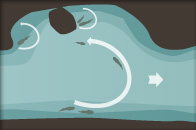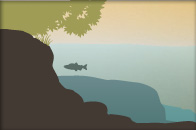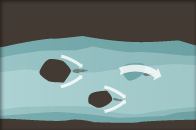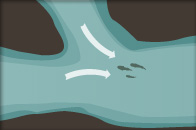River Fishing
Many anglers consider river fishing to be one of the most relaxing freshwater fishing experiences because it doesn't require much gear, and can easily be done from a canoe, kayak, or while wading. Find river fishing tips and more information.
Imagine spending a quiet day casting on a beautiful secluded river or stream, waiting in anticipation for the moment when a smallmouth bass or rainbow trout rises from the flowing water to slurp up your fly or take your lure.
What should you do if you have never gone river fishing before or don't know where to start? No problem, it's simple to learn how to fish in a river. Start by learning about the freshwater tackle and river fishing gear you should use, then just follow a few basic river fishing tips that will help you understand where fish are most likely to be found in these types of waterways.
River Fishing Tips
Fishing in a river requires you to think about where fish will seek refuge from current and predators. Consider areas where there is structure along the bank, such as sunken trees or overhanging branches, but don't forget that there are plenty of spots in a river that will hold fish. The best fishing rivers offer a multitude of natural structures that not only offer protection from current and predators, but also serve as ideal spots for game fish to ambush prey. Use these basic river fishing tips to help you locate fish in different areas of a river.
Calm Areas Or Eddies
 Find the backwaters. When the current in a river is strong or moving quickly, fish often seek refuge in the calmer backwater areas. Cast upstream and allow your lure or fly to drift down toward calm areas or eddies.
Find the backwaters. When the current in a river is strong or moving quickly, fish often seek refuge in the calmer backwater areas. Cast upstream and allow your lure or fly to drift down toward calm areas or eddies.
Stumps And Vegetation
 Keep an eye out for stumps and vegetation. Areas underneath overhanging branches or bushes are also good spots to try because these areas offer shade as well as protection from birds and other predators.
Keep an eye out for stumps and vegetation. Areas underneath overhanging branches or bushes are also good spots to try because these areas offer shade as well as protection from birds and other predators.
Island Or Rock Piles
 Look near islands or rock piles. On the downstream side of sandy islands or rock piles, you will find calmer water. Fish often rest, facing upstream, on the downstream side of a rock pile or island. These pockets of water may be large or small, but a smart cast in the right spot is likely to land you a fish.
Look near islands or rock piles. On the downstream side of sandy islands or rock piles, you will find calmer water. Fish often rest, facing upstream, on the downstream side of a rock pile or island. These pockets of water may be large or small, but a smart cast in the right spot is likely to land you a fish.
Merging Currents
 Focus on areas where there are current shifts or changes. These areas might be merging currents, drop-offs, feeder springs, or any place where the current slows and food sources can collect.
Focus on areas where there are current shifts or changes. These areas might be merging currents, drop-offs, feeder springs, or any place where the current slows and food sources can collect.
River Fishing Techniques
You already know about the freshwater gear to use and where to find the fish, now you just need to know which techniques and baits will work best when river fishing. There are a few simple techniques you can use to start with. Once you get more experience with fishing in rivers and streams, you can always learn new techniques.
Bottom Bouncing
One of the more common river fishing tips is that of using a Carolina Rig to bottom bounce a live bait (such as a crawfish or minnow) or soft plastic bait along with the current. This is can be a particularly good technique to use from smallmouth bass around ledges or drop-offs near deeper channels or cuts.
Upstream Casting
Cast upstream using in-line spinners for brown trout or rainbow trout. Remember that natural food sources will be drifting downstream, so this creates a natural presentation. You’re your spinner upstream, and then reel downstream.
River Jigging
For many anglers, jigs are considered the best lures for river fishing near the mouth of a river, in areas of slower current, and near shorelines for walleye. Using 1/4 to 1/8-ounce jigs will work well in most situations. You can use up to 1 ounce in areas of stronger current. Find more information for how to jig in the next section.
KEEP LEARNING

TakeMeFishing x Teen Vogue
Join us on a creative journey as fashion designer Ahmrii Johnson walks us through her collaborative vision and process with Teen Vogue and fashion brand, Rentrayage, to create a special piece.
LEARN MORE

First Catch Center Trailer Gallery
FCC Trailer Photo Gallery
LEARN MORE

How to Tie a Duncan Knot
Learn to tie a Duncan knot by following these five simple steps. Watch our new video.
LEARN MORE


.png?lang=en-US&ext=.png)